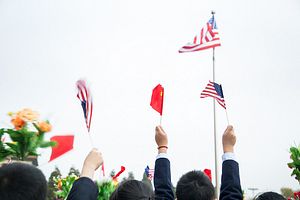Trans-Pacific View author Mercy Kuo regularly engages subject-matter experts, policy practitioners and strategic thinkers across the globe for their diverse insights into the U.S. Asia policy. This conversation with Phillip Yin ̶ Founder and Manager Director of Newsroom Investments; previously former launch anchor for CGTN America and anchor for CNBC and Bloomberg News ̶ is the 145th in “The Trans-Pacific View Insight Series.”
With your extensive media and business background, assess U.S. media coverage of U.S.-China trade war.
The coverage has been extensive, but much of it inaccurate. Reporters struggle with quick deadlines trying to oversimplify a complex relationship that we’ve had with China over the past few decades. China has already diversified its [country customer base]. In the past, the U.S. accounted for nearly 50 percent of exports from China, but today that number is less than a third, if not less when accounting for “parts and goods” shipped to China for final assembly.
Explain the difference between partisan and political media coverage of China.
It’s a great question that involves an hours long speech. China’s political and media coverage is essentially one. The Chinese government works closely with businesses with a top down approach. There aren’t any official opposing views, thus the Chinese speak with one voice. In the U.S. we have many different viewpoints between the Democrats and Republicans. That said, there are different opinions especially on trade even within the party. The result, often, is mixed messages from the White House, Congress, and local/state governments when it comes to providing a consistent message in dealing with China.
As a former news anchor and Chinese American, explain the dangers of perpetuating U.S.-China media misperceptions.
The dangers have always been there, but today, with the polarization of media, it’s causing a type of business racism that goes beyond just only race, but also country of origin of products and/or services. It’s hard to separate business relationships, but I fear a generalization of business discrimination that ultimately is bad for both parties. These generalizations, if left unchecked, will make future collaborative efforts much more difficult. Essentially, take a working relationship, add distrust, distorted facts, and a personal element of business bullying, and you can see we are moving into a dangerous territory.
Shaping public perceptions and attitudes is a dimension of soft power – evaluate U.S. and Chinese soft power effectiveness.
I’m not a big fan of “soft power.” Power is leverage, whether it is obvious or behind the scenes in a diplomatic fashion. China has been quite strategic over the past two decades in how they see their role in the global economy. The U.S. has been playing good cop/bad cop. Ultimately that puts corporate America in a difficult position, as the prerequisite for any deal is: Can it be enforced? How long will it last? Can I trust the other side in good faith? Today’s volatility threatens our ability to formulate a good long-term strategy for the benefit of the U.S., its businesses, and ultimately our fellow citizens.
Explain factors behind rising perceptions of the “China threat” in the U.S. policy community.
I think the address at 1600 Pennsylvania Ave has had a major impact. Freedom of speech is of the upmost importance, but the abuse of it had significant unintended consequences. The combination of mixed messages from our officials and the media mis-stating facts without context creates an environment that feeds what people want to believe in the short run, rather than looking for constructive solutions that benefit the U.S. in the long run.

































